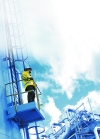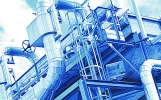

Yokogawa has come a long way in making its message clear to the world of process automation. In 2004, the company embarked on a full-scale global marketing campaign to make customers aware of its focus on system reliability, security, dependability, and robustness. Dubbed 'Vigilance', the campaign created a unified message for the company and greatly helped expand awareness of the Yokogawa brand and corporate philosophy.
While the Vigilance campaign was good at articulating the company's philosophy, articulating the value proposition of the company's product, application, and services offering remains a key challenge for the company. In 2005, Yokogawa began a campaign called VigilantPlant, which is designed to raise customer awareness of Yokogawa's solution set and where it fits in the Vigilance scheme.
VigilantPlant is essentially a path toward Operational Excellence (OpX) placed in the context of Yokogawa's offerings and capabilities.
The core building blocks of the VigilantPlant solution fit well into the model of operational excellence that consists of a continuous improvement cycle of measurement, control, and optimisation. At the measurement level, VigilantPlant includes Yokogawa's solutions for analysis, quality control, sensing, and actuation. The control domain encompasses production control and safety management as well as data acquisition and logic control.
The optimisation domain within VigilantPlant consists of production management, advanced control, asset management, and operational efficiency. While the VigilantPlant encompasses all of Yokogawa's products and services, there are several key offerings from the company that embody VigilantPlant that are either new and emerging offerings or are simply not as well understood by the end user community.
These key offerings were analysed in a report, and include the ProSafe-RS safety system, the Vnet/IP control network based on Gigabit Ethernet, Yokogawa's alarm management and production management capabilities, and its expertise in Fieldbus and plant asset management (PAM).

Operational excellence
Yokogawa has developed VigilantPlant as a means of attaining what it terms Operational Excellence (OpX) placed in the context of Yokogawa's offerings and capabilities. Yokogawa's vision with VigilantPlant is to create an environment where plant personnel and operators are well-informed, alert, and ready to take action. Pending abnormal events are detected well before they become a problem, and the role of the operator can be transformed from reacting to problems to making intelligent decisions about the process to optimise plant and business performance.
The VigilantPlant philosophy is aimed at eliminating unplanned downtime and allowing businesses to adapt and change quickly and with agility to shifting market conditions and customer demands. This is consistent with ARC's view that giving personnel access to the right information at the right time combined with the ability to take action is crucial for achieving OpX and is the foundation of realtime performance management (RPM).
Three component strategy
Yokogawa breaks its VigilantPlant strategy into the three basic components of See, Know, and Act. To 'See' means that there is clear visibility of plant information in the form of stable and accurate realtime information exchange throughout the plant. To 'Know' means that predictive intelligence anticipates changes and helps users plan actions in advance. To 'Act' with agility means an ability to make decisions quickly and accurately based on the information provided in steps one and two. The core building blocks of the VigilantPlant solution fit well into the six sigma model of operational excellence that consists of a continuous improvement cycle of measurement, control, and optimisation.
At the measurement level, VigilantPlant includes Yokogawa's solutions for analysis, quality control, sensing, and actuation. The control domain encompasses production control and safety management as well as data acquisition and logic control. The optimisation domain within VigilantPlant consists of production management, asset management, and operational efficiency.
Ethernet-based networking technology
The first component is Yokogawa's new Vnet/IP open, Ethernet-based networking technology. It provides the common information infrastructure that is necessary to achieve the vision of CPAS that ARC espouses, and provides a common backbone for information exchange across all VigilantPlant component. Yokogawa's ProSafe-RS is the company's new approach to safety and critical condition management.
Cutting vertically across the control and optimisation domains is Yokogawa's new solution for alarm management called AAASuite, which is presented in this report. Yokogawa's offerings at the production management/MES level are a crucial part of the company's offering for production optimisation, and are often underestimated or misunderstood. In the sensing and actuation domain, Yokogawa's offerings for Fieldbus technology are an essential component, and go hand in hand with the company's capabilities in PAM at the optimisation level.
The VigilantPlant process of See, Know, and Act is ultimately a way to achieve OpX in specific aspects of plant operations. For achieving OpX in plant safety, for example, the AAASuite alarm management offering fills the role of giving operators improved visibility into the alarming scheme of the plant by eliminating unnecessary alarms and giving users improved visibility into abnormal situations as they develop so they can take action before there is an incident. The Know phase is addressed by the ProSafe-RS safety system, which controls safety operations and enable preventive action to be taken. The Exapilot Non-Routine Operation Navigator fills the Act role by bringing operations back to normal as quickly as possible. If there is a shutdown, Exapilot will minimise downtime and ensure a smooth re-startup.
Open and reliable network infrastructure
One of the key areas where Yokogawa is making innovations to its control system infrastructure is in control networks. Today, Yokogawa offers a dedicated protocol that ensures high levels of reliability and realtime functionality in the form of Vnet, which filled many of the requirements that commercially available networking could not fill at the time of its release.
Vnet is designed to be deterministic, high-speed, reliable, and secure, with the ability to be deployed in large-scale implementations. Widespread availability and increasing reliability and determinism of Ethernet-based networks, however, has eroded the base for proprietary control networks considerably, and most suppliers have switched to Ethernet-based control networks over the past several years.
Ethernet holds significant potential to deliver bottom-line savings in industrial automation. While ability to take full advantage the commercial sales volume and supply availability in the commercial market is favourable to some, use of this common platform to enable even further capabilities such as remote monitoring and diagnosis, global data availability, and ultimately a truly distributed automation environment is where the true value proposition of the future lies. While Vnet is stable, deterministic, and reliable, it lacked the openness and promise of global data availability promised by Ethernet.
Vnet/IP: Into the Ethernet age
Yokogawa's answer to incorporating open networking technology in its systems comes with the release of the Vnet/IP control network, which is available in the latest major version release of the CENTUM CS 3000 control system. The first widely available PAS control network based on Gigabit Ethernet, Vnet/IP offers redundant communications and communications band partitioning over standard Ethernet, while providing the high reliability and deterministic response required for process automation. Vnet/IP offers 10 times the throughput of Vnet, and routers are available that can switch between Vnet and Vnet/IP.
The openness of Vnet/IP makes it easier for the user to connect non-CENTUM components to the control network through Vnet/IP's TCP/IP communications capabilities and enable users to configure their networks with commercially available network equipment. Data from third party devices can be integrated with CENTUM CS 3000 through the GSGW process data server on Vnet/IP.
Since Vnet/IP is Ethernet-based, users have the ability to choose from a wide range of hardware, and Yokogawa does not specify which hardware vendors are to be used. Yokogawa has, however, certified and tested Cisco and Dell hardware for Vnet/IP, which is consistent with the Ethernet-based offerings of many other PAS suppliers.
Vnet/IP enables remote operations
The value proposition of Ethernet lies primarily in the openness it provides, both within the plant or factory and beyond. Yokogawa understands this and sees Ethernet as an enabling technology. A key area where Yokogawa feels that Vnet/IP provides a business benefit is remote monitoring and operations. Wireless devices, mobile computers, and additional HMI stations can be deployed from anywhere off the Vnet/IP network. Yokogawa is already offering solutions that allow operators to use Pocket PC-based PDAs and have access to HMI workstation functionality while roaming the plant.
Migration and coexistence with Vnet Protocol
While Vnet/IP collapses the communication architecture within the CENTUM architecture, unifying the control and information bus, Yokogawa still plans to offer and support the Vnet protocol, and plans on coexistence between Vnet and Vnet/IP. Both protocols can exist in the same system through network partitioning. CENTUM users can migrate to Vnet/IP in a phased manner, and migration to Vnet is a subcomponent of the overall CENTUM V and CENTUM XL migration plan to CENTUM CS 3000 with no changes in field wiring.
Other aspects discussed in the 28-page report include:
* Advanced safety system solution, VigilantPlant.
* ProSafe, with Safety Integrity Levels from SIL 1 to SIL 4.
* ProSafe-RS, 'separate yet integrated' safety systems.
* Continued support of legacy safety systems.
* Safety transmitters with SIS solution.
* Alarm management strategies.
* Production management and optimisation strategies.
* Path to OpX for asset management.
| Tel: | +27 11 831 6300 |
| Email: | [email protected] |
| www: | www.yokogawa.com/za |
| Articles: | More information and articles about Yokogawa South Africa |

© Technews Publishing (Pty) Ltd | All Rights Reserved